Reviewing our region's progress on aging, greenspaces and sustainability
by Alan DeLaTorre, February 25 2016
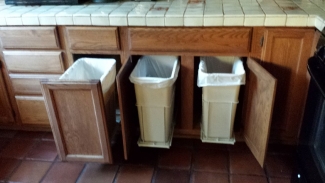 One of my first memories of recycling is tied to my grandparents’ home. In the kitchen there are several cleverly designed pull-out drawers for garbage, bottles and cans built into the cabinets. The lesson that my sister and I learned as teenagers was that we had a responsibility to keep our communities clean because other people – i.e., current and future generations – also deserved to live, play and work on our shared planet.
One of my first memories of recycling is tied to my grandparents’ home. In the kitchen there are several cleverly designed pull-out drawers for garbage, bottles and cans built into the cabinets. The lesson that my sister and I learned as teenagers was that we had a responsibility to keep our communities clean because other people – i.e., current and future generations – also deserved to live, play and work on our shared planet.
In retrospect, I was not yet thinking about intergenerational mentoring or environmental stewardship, but those drawers are now important to my understanding of gerontology and urban ecology. Decades later, my professional life as a gerontologist has given me the opportunity to better understand the connections between our aging population and the environment, and how older adults are critical in our regional pursuit of sustainable development.
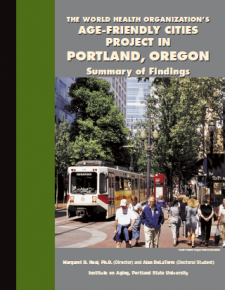 In 2006, Portland State University’s Institute on Aging (IOA) was invited to participate in the World Health Organization’s (WHO) Age-Friendly Cities project. This resulted in a set of local findings used by the WHO – along with research findings from 32 other cities in 21 other countries – to produce a global guide for creating communities good for all ages and abilities.
In 2006, Portland State University’s Institute on Aging (IOA) was invited to participate in the World Health Organization’s (WHO) Age-Friendly Cities project. This resulted in a set of local findings used by the WHO – along with research findings from 32 other cities in 21 other countries – to produce a global guide for creating communities good for all ages and abilities.
At the time the project was proposed, I was completing my coursework as a doctoral student in urban studies, focusing on gerontology and urban planning. When the director of the institute offered me the opportunity to focus my research assistantship on the global project, I jumped at the chance – even though the timeline was very short, and it was just the two of us available to carry out the project.
The research method involved focus groups with older adults, service providers and caregivers of older adults who were asked about age-friendly features, barriers and suggestions for improvement. That research set in motion Portland’s age-friendly efforts, which have continued to evolve.
The global and Portland-based findings covered many topics (eight domains, in fact) that broadly addressed physical, social and service environments. The barrier to age friendliness most reported was affordable housing –a growing issue in 2016. The age-friendly feature most reported was the presence of natural features and greenspaces.
When IOA Director Dr. Margaret Neal and I attended the first age-friendly global gathering in London in 2007 to report Portland’s findings, we learned that one of the common barriers to age friendliness on a global scale was the lack of park maintenance and infrastructure (e.g., benches, paths) that facilitate older persons’ enjoyment of those spaces. I have to admit, I was surprised by the commonalities I heard and was struck by the fact that older adults in countries such as Germany and China were facing similar issues to older Portlanders.
We left that WHO-sponsored international meeting feeling that if we focused our efforts at the local level, we could make a difference in the lives of our shared common resource: the aging population.
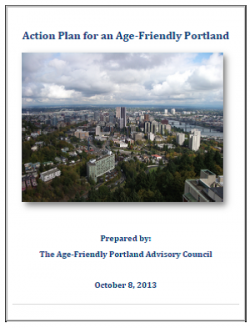 Several years after the original WHO project, my dissertation research focused on understanding the factors that affect sustainable, affordable housing development for older adults in Portland. The project reinforced the Portland-based and global research findings that suggest that housing for older adults should be located near parks and greenspaces in order to enhance physical activity and social connectivity.
Several years after the original WHO project, my dissertation research focused on understanding the factors that affect sustainable, affordable housing development for older adults in Portland. The project reinforced the Portland-based and global research findings that suggest that housing for older adults should be located near parks and greenspaces in order to enhance physical activity and social connectivity.
Around the same time I completed my dissertation, Portland City Council was preparing to adopt the Action Plan for an Age-Friendly Portland (October 2013). The Action Plan aimed to move beyond the original research efforts carried out by PSU and others, in an attempt to implement actions developed by the Advisory Council for an Age-Friendly Portland. (Note: In 2015 Multnomah County also joined the WHO and AARP Age-Friendly Networks and will develop an action plan in 2016-17).
The Portland action plan includes several items that address Portland’s natural features and greenspaces. For example, Action Item 3.1 – Improve Existing Natural Features and Green Spaces builds on the original WHO-based research from 2007 that identified natural features and greenspaces as one of Portland’s top age-friendly features; it recognizes that our parks and greenspaces represent amenities truly unique to our region, but that accessibility is still lacking and that the distribution of these amenities is not equitable across Portland and the region.
Some of the age-friendly suggestions offered in the plan include: (1) enhancing accessibility by improving bus routes, sidewalks, clear and safe pathways, and legible wayfinding signage to our greenspaces, including improved benches, water fountains, exercise stations and recreational programs; (2) ensuring that one-time and occasional events adhere to accessibility standards that allow people of all ages and abilities to enjoy the facilities; and (3) creating additional parks and greenspaces in underserved areas such as East Portland. Additional suggestions include fostering more gardening and local food production, as well as developing best practices and guidance for producing inclusive and accessible social spaces.
However, for specific guidance on improving the accessibility of Portland’s parks and recreational spaces, one should turn to Portland’s Transition Plan, specifically the Portland Parks and Recreation (PPR) Supplement to the Transition Plan, which identifies barriers that impede access to city facilities open to the public. The PPR supplement was needed due to the large number – 260 – of publicly accessible park facilities, and resulted in an evaluation process that took longer to accomplish than those of other bureaus. A total of 20,355 barriers were identified.
The PPR-specific transition plan lays out priorities for all 20,000+ barriers over the next 20 years, in a tiered system. It addresses barriers that are mainly maintenance-based (e.g., overgrown plants, evening of surfaces) and capital improvement projects (e.g., new paths, accessible restrooms).
I would like also to call attention to Georgena Moran’s advice in a January Outside Voice post that suggests we go beyond objective accessibility requirements (e.g., ADA guidelines) and push for universal design approaches to be incorporated into mainstream design and development practices. As we begin to make investments to remove the barriers identified in the Transition Plan, as well as when creating new parks and recreational spaces, it’s the perfect time to design innovatively and to break away from design that meets minimum standards merely compliant with code.
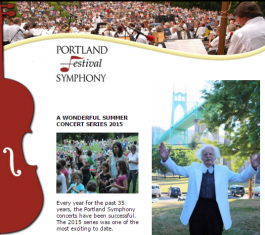 Returning to the importance of the lesson I learned from my grandparents – being a steward of the environment for current and future generations – this past summer provided a glimpse at what that might look like. I walked from my home in North Portland with my wife, daughter and father (now a grandfather himself) to a symphony performance in Peninsula Park. We were able to wheel my one-year old from our home to the park, and once we arrived, up and down accessible ramps and over well-designed pathways. A great music program for all generations, including an instrument petting zoo, showed how accessible physical environments and inclusive social activities can create great age-friendly events in our local parks.
Returning to the importance of the lesson I learned from my grandparents – being a steward of the environment for current and future generations – this past summer provided a glimpse at what that might look like. I walked from my home in North Portland with my wife, daughter and father (now a grandfather himself) to a symphony performance in Peninsula Park. We were able to wheel my one-year old from our home to the park, and once we arrived, up and down accessible ramps and over well-designed pathways. A great music program for all generations, including an instrument petting zoo, showed how accessible physical environments and inclusive social activities can create great age-friendly events in our local parks.

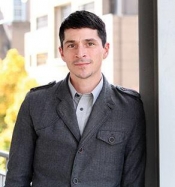 Alan DeLaTorre is an environmental gerontologist who is passionate about translating research into policy and practice. He serves as a research associate at Portland State University’s Institute on Aging and is the co-coordinator for the Age-Friendly Portland and Multnomah County initiatives. Additionally, he is the immediate past president of the Oregon Gerontological Association, commissioner on the Portland Commission on Disability, co-chair of the Environmental Design Committee for the Association for Gerontology in Higher Education, and serves as an appointed volunteer with AARP Oregon with a focus on age-friendly and livable communities.
Alan DeLaTorre is an environmental gerontologist who is passionate about translating research into policy and practice. He serves as a research associate at Portland State University’s Institute on Aging and is the co-coordinator for the Age-Friendly Portland and Multnomah County initiatives. Additionally, he is the immediate past president of the Oregon Gerontological Association, commissioner on the Portland Commission on Disability, co-chair of the Environmental Design Committee for the Association for Gerontology in Higher Education, and serves as an appointed volunteer with AARP Oregon with a focus on age-friendly and livable communities.
Add new comment